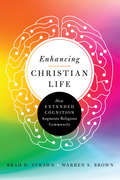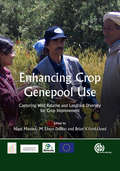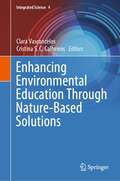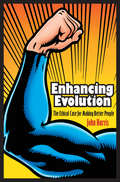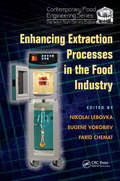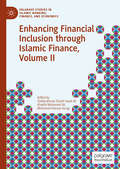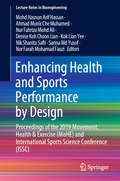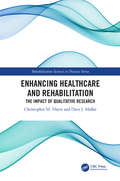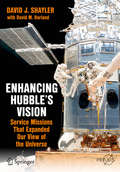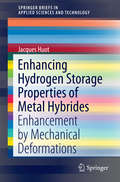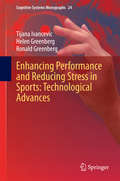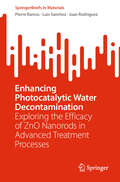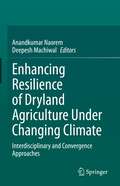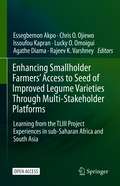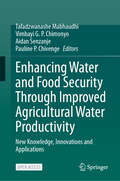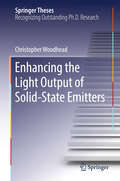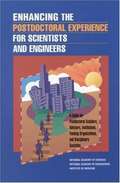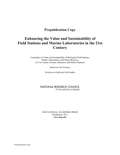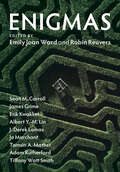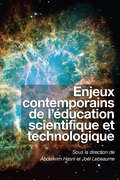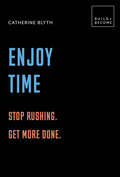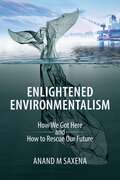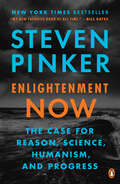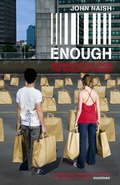- Table View
- List View
Enhancing Christian Life: How Extended Cognition Augments Religious Community
by Brad D. Strawn Warren S. BrownNo one is really Christian on their own. But often the religious life is seen as individual, private, and internal—resulting in a truncated, consumeristic faith. And what if that kind of individualistic Christianity is built on a fundamental misunderstanding of human nature? According to psychologists Brad Strawn and Warren Brown, it's time to rethink the Christian life in light of current research on the human mind, particularly with a deeper understanding of the process called "extended cognition." Using insights from neuroscience, psychology, and philosophy, they argue in Enhancing Christian Life that persons must be understood as not only embodied and embedded within particular contexts, but also extended beyond the body to encompass aspects of the physical and social world. Embracing a vision of the Christian life as extended into interactions with a local network of believers, they help us discover a fuller, more effective way to be Christian. After exploring the psychological dynamics of extended cognition, including how the mind is "supersized" by the incorporation of physical tools and social networks, Strawn and Brown consider implications for spiritual practices, congregational life, and religious language and traditions, which they describe as mental "wikis." The formation of robust Christian life, they show, is a process that takes place within a larger mesh of embodiment and mind—broader, deeper, and richer than we could ever be on our own.
Enhancing Crop Genepool Use: Capturing Wild Relative and Landrace Diversity for Crop Improvement
by Nigel Maxted Ben Vosman Brian Ford-Lloyd Jeremy Pritchard Colette Broekgaarden M Ehsan DullooMaintaining food security in the face of human population increase and climate change is one of the critical challenges facing us in the 21st Century. Utilisation of the full range of agrobiodiversity will be a necessary tool in addressing this challenge. In this book a team of international contributors review all aspects of utilization and conservation of crop wild relative (CWR) and landrace (LR) diversity as a basis for crop improvement and future food security. Enhancing Crop Genepool Use covers four key areas: · Characterization techniques - novel 'omics' techniques and predictive tools that can be used to identify adaptive traits and expedite plant breeding. · Conservation strategies - how to develop national, regional and global CWR and LR conservation strategies, how better to target conservation to meet the needs of the plant breeding community, and how to integrate CWR and LR diversity into existing biodiversity conservation programmes. · Facilitating CWR and LR use - pre-breeding using 'exotic' germplasm, meeting breeders' needs, integrating the conservation and user communities, and policy enhancement. · Informatics development - improving characterization, trait and conservation data management and accessibility, and inter-information system operability. This book will appeal to a wide array of specialists and postgraduate students, such as those working in the fields of agrobiodiversity conservation and use, conservation, ecology, botany, genetics, plant breeding and agriculture.
Enhancing Crop Genepool Use: Capturing Wild Relative and Landrace Diversity for Crop Improvement
by Ben Vosman Brian Ford-Lloyd Jeremy Pritchard Colette BroekgaardenBased on the 2014 'Enhanced Genepool Utilization ? Capturing wild relative and landrace diversity for crop improvement' conference , in this book a team of international contributors address all aspects of utilization and conservation of crop wild relative (CWR) and landrace (LR) diversity for crop improvement. Focussing on characterisation techniques, conservation strategies, facilitating CWR and LR use and informatics development, this book highlights exotic plant germplasm as a potentially critical but neglected resource for crop improvement.
Enhancing Environmental Education Through Nature-Based Solutions (Integrated Science #4)
by Clara Vasconcelos Cristina S. C. CalheirosThis Book presents innovative and state of the art studies developed in Environmental Education in different countries to highlight this theme and promote its implementation all over the world. It will give a scientific perspective of Nature-based solutions to promote environmental education in all citizens and a more educational perspective as to how this approach can be implemented at schools and universities. Not less important is that includes science communication as a key factor for training and disseminating about the environment. The invited authors are recognized experts with excellent work developed in Environmental Education.This contributed volume presents innovative and creative work in the area giving a step forward in the implementation of Environmental Education, namely as a target of 2020 United Nations Agenda for Sustainable Development. The invitation of authors from many different countries allows the creation of a network and subsequently the book will bring concrete ideas as to how to develop operational capacities to bring added values to Environmental Education at an international level.
Enhancing Evolution: The Ethical Case for Making Better People (Science Essentials Ser.)
by John HarrisIn Enhancing Evolution, leading bioethicist John Harris dismantles objections to genetic engineering, stem-cell research, designer babies, and cloning and makes an ethical case for biotechnology that is both forthright and rigorous. Human enhancement, Harris argues, is a good thing--good morally, good for individuals, good as social policy, and good for a genetic heritage that needs serious improvement. Enhancing Evolution defends biotechnological interventions that could allow us to live longer, healthier, and even happier lives by, for example, providing us with immunity from cancer and HIV/AIDS. Further, Harris champions the possibility of influencing the very course of evolution to give us increased mental and physical powers--from reasoning, concentration, and memory to strength, stamina, and reaction speed. Indeed, he says, it's not only morally defensible to enhance ourselves; in some cases, it's morally obligatory. In a new preface, Harris offers a glimpse at the new science and technology to come, equipping readers with the knowledge to assess the ethics and policy dimensions of future forms of human enhancement.
Enhancing Extraction Processes in the Food Industry (Contemporary Food Engineering)
by Eugene Vorobiev Nikolai Lebovka Farid ChematExtraction is an important operation in food engineering, enabling the recovery of valuable soluble components from raw materials. With increasing energy costs and environmental concerns, industry specialists are looking for improved techniques requiring less solvents and energy consumption. Enhancing Extraction Processes in the Food Industry is a
Enhancing Financial Inclusion through Islamic Finance, Volume II (Palgrave Studies in Islamic Banking, Finance, and Economics)
by Khalifa Mohamed Ali Abdelrahman Elzahi Saaid Ali Mohamed Hassan AzragThis book is the second of two volumes which highlight the concept of financial inclusion from the Islamic perspective. An important element of the Sustainable Development Goals (SDGs), financial inclusion has been given significant prominence in reform and development agendas proposed by the United Nations and G-20. The significance of Islamic financial inclusion goes beyond improved access to finance to encompass enhanced access to savings and risk mitigation products, as well as social inclusion that allows individuals and companies to engage more actively in the real economy. It represents one of the important drivers of economic growth. This volume explores the financial risks associated with lending to low-income groups due to high poverty levels and the lack of collateralization mechanisms. The first book on the market to provide empirical evidence of Islamic microfinance, deposit insurance and micro-entrepreneurship through the analysis of models and country case studies, this edited collection will be of value to those researching development finance, financial inclusion and Islamic finance.
Enhancing Health and Sports Performance by Design: Proceedings of the 2019 Movement, Health & Exercise (MoHE) and International Sports Science Conference (ISSC) (Lecture Notes in Bioengineering)
by Mohd Hasnun Arif Hassan Ahmad Munir Che Muhamed Nur Fahriza Mohd Ali Denise Koh Choon Lian Kok Lian Yee Nik Shanita Safii Sarina Md Yusof Nor Farah Mohamad FauziThis book gathers papers presented at the 2019 Movement, Health & Exercise (MoHE) Conference and International Sports Science Conference (ISSC). The theme of this year’s conference was "Enhancing Health and Sports Performance by Design". The content covers (but is not limited to) the following topics: exercise science; human performance; physical activity & health; sports medicine; sports nutrition; management & sports studies; and sports engineering & technology.
Enhancing Healthcare and Rehabilitation: The Impact of Qualitative Research (Rehabilitation Science in Practice Series)
by Christopher M. Hayre Dave J. MullerSummary Description This book is primarily a celebration of the qualitative work undertaken internationally by a number of experienced researchers. It also focuses on developing the use of qualitative research for health and rehabilitative practitioners by recognizing its value methodologically and empirically. We find that the very nature of qualitative research offers an array of opportunities for researchers in being able to understand the social world around us. Further, through experience and discussion, this book identifies the multifaceted use of qualitative methods in the healthcare and rehabilitative setting. This book touches on the role of the researcher, the participants involved, and the research environment. In short, we see how these three central elements can affect the nature of qualitative work in attempts to offer originality. This text speaks to a number of audiences. Students who are writing undergraduate dissertations and research proposals, they may find the myriad of examples stimulating and may support the rationale for methodological decisions in their own work. For academics, practitioners, and prospective qualitative researchers this book also aims to demonstrate an array of opportunism in the field of qualitative research and how they may resonate with arguments proffered. It is anticipated that readers will find this collection of qualitative examples not only useful for informing their own research, but we also hope to enlighten new discussions and arguments regarding both methodological and empirical use of qualitative work internationally. Features Encompasses the importance of qualitative research and how it can be used to facilitate healthcare and rehabilitation across a wide range of health conditions. Evaluates empirical data whilst critically applying it to contemporary practices. Provides readers with an overview with future directions and influence policy makers in order to develop practice. Focuses on an array of health conditions that can affect groups of the population, coincided with life issues and the care and family support received. Offers innovative methodological insights for prospective researchers in order to add to the existing evidence base.
Enhancing Hubble's Vision
by David J. Shayler David M. HarlandThis book tells the story of the four missions to maintain Hubble's successful operation. Between 1997 and 2009 these repaired, serviced and upgraded the instruments on the telescope to maintain its state-of-the-art capabilities. It draws on first hand interviews with those closely involved in the project. The spacewalking skills and experiences gained from maintaining and upgrading Hubble had direct application to the construction of the International Space Station and help with its maintenance. These skills can be applied to future human and robotic satellite servicing and maintenance activities as well, not only in Earth orbit but at locations deeper in space. A companion to this book, The Hubble Space Telescope: From Concept to Success, relates the events of the Telescope's launch in 1990 and its rough start, after a 20-year struggle to place a large optical telescope in orbit. Originally intended to operate for fifteen years, Hubble has just passed its 25th anniversary, and there is every expectation that it will survive for thirty years. Despite its early problems, the Hubble Space Telescope has become a lasting legacy of the Space Shuttle program, and indeed is a national treasure.
Enhancing Hydrogen Storage Properties of Metal Hybrides
by Jacques HuotThis book shows how severe plastic deformation techniques could be used to enhance the hydrogen storage properties of metal hybrides. The mechanochemical techniques of ball-milling (BM), Cold Rolling (CR), Equal Chanel Angular Pressing (ECAP) and High Pressure Torsion (HPT) are covered. Each technique is described and critically assessed with respect to its usefulness to process metal hybrides at an industrial scale.
Enhancing Performance and Reducing Stress in Sports: Technological Advances
by Tijana Ivancevic Helen Greenberg Ronald GreenbergThis book is designed to help athletes and individuals interested in high sports performance in their journey towards the perfection of human sports abilities and achievements. It has two main goals: accelerating the acquisition of motor skills and preparing and vigilantly reducing the recovery time after training and competition. The Diamond Sports Protocol (DSP) presents state-of-the-art techniques for current sport and health technologies, particularly neuromuscular electrical stimulation (Sports Wave), oxygen infusion (Oxy Sports), infrared (Sports Infrared Dome) and lactic acid cleaning (Turbo Sports). The book suggest DSP as an essential part of every future athlete's training, competition and health maintenance. The book is for everyone interested in superior sports performance, fast and effective rehabilitation from training and competition and sports injury prevention.
Enhancing Photocatalytic Water Decontamination: Exploring the Efficacy of ZnO Nanorods in Advanced Treatment Processes (SpringerBriefs in Materials)
by Pierre Ramos Luis Sánchez Juan RodríguezThe book reviews the fundamentals of advanced oxidation processes (AOPs) technologies to degrade hazardous organics via photocatalysis of 1-dimensional zinc-oxide (ZnO). One-dimensional ZnO nanorods (ZnO-NRs) have been of utmost interest due to their high surface area, efficient charge transport, and superior photosensitivity. These features make ZnO-based nanorods exciting candidates for applications in photocatalysis. Even though photocatalysis using bare ZnO nanorods is useful in pollutant remediation, several drawbacks such as high recombination of photo−excited charge carriers and ineffective operation of sunlight make it less effective. This book thus presents a review of the current modification strategies carried out to increase the ZnO nanorods photoactivity, such as enhancing the photocatalytic activity of ZnO through modification of its electronic and optical properties, doping metal/nonmetal atoms, depositing noble metals, constructing heterojunctions, and coupling carbon materials. This book provides invaluable insights for researchers, engineers, and policymakers seeking sustainable solutions for pollutant degradation. Furthermore, the discussion on future directions illuminates the potential of ZnO nanorods as a promising photoactive material, fostering continued innovation and progress in the field.
Enhancing Resilience of Dryland Agriculture Under Changing Climate: Interdisciplinary and Convergence Approaches
by Deepesh Machiwal Anandkumar NaoremThis contributed volume describes management practices based on interdisciplinary and convergence science approaches from different disciplines of agricultural science to enhance the resilience of dryland agriculture. The main focus of this book is to address the current issues and trends along with future prospects and challenges in adopting salient agricultural management practices in drylands globally under a climate-change scenario. Climate change and global warming have profound repercussions on increasing frequency, severity, and duration of droughts and/or floods, which may have implications for future productivity of dryland agriculture, e.g., more water shortages or abundances and high or low runoff rates, diminished crop yields, and reduced water productivity. In past few years, many technological advancements and management strategies have been evolved to tackle the climate-induced risks of dryland agriculture considering interdisciplinary and convergence approaches that integrate knowledge from multi-disciplines. This book is an attempt to bridge the gap in literature by unraveling controversies and characteristics of dryland ecosystems under the changing climate and dealing with detailed procedures of applying the advanced practices adapted to climate change for management of dryland agriculture. This edited book is of interest to ecologists, economists, environmentalists, geologists, horticulturalists, hydrologists, soil scientists, social scientists, natural resource conservationists and policy makers dealing with dryland agriculture. This book offers a broad understanding of dryland agriculture and assists the reader to identify both the current as well as the probable future state of dryland agriculture in a global context.
Enhancing Smallholder Farmers' Access to Seed of Improved Legume Varieties Through Multi-stakeholder Platforms: Learning from the TLIII project Experiences in sub-Saharan Africa and South Asia
by Rajeev K. Varshney Essegbemon Akpo Lucky O. Omoigui Chris O. Ojiewo Issoufou Kapran Agathe DiamaThis open access book shares the experiences of Tropical Legumes III (TLIII) project in facilitating access to seed of improved legume varieties to smallholder farmers through innovation platforms. It highlights practices and guiding principles implemented in eight developing countries of sub-Saharan Africa and South Asia. This book details key processes that respective teams employed to create an innovation space that delivers seed, other inputs, knowledge and financial services to agricultural communities and most importantly, the underserved farmers in remote areas of the drylands. It offers valuable insights into the pathway to establishing, promoting and operating innovation platforms to enhance the performance and competitiveness of legume crops’ value chains, and addresses critical issues that must be considered to make innovation platforms more sustainable and attractive to beneficiaries. The book offers a wealth of practical insights for development workers, technical staff, and project managers. This publication is all about TLIII community of practice. It will definitely inspire other development workers and scientists to share their own experiences for others to learn from.
Enhancing Water and Food Security Through Improved Agricultural Water Productivity: New Knowledge, Innovations and Applications
by Tafadzwanashe Mabhaudhi Vimbayi G. P. Chimonyo Aidan Senzanje Pauline P. ChivengeThis open-access edited book provides a synthesis of knowledge on Water Productivity (WP) and its role in addressing global challenges related to water and food insecurity, as well as climate change. It explores how increasing WP can contribute to achieving several Sustainable Development Goals (SDGs) in the global South, with a focus on SDG 2, 6, and 12. The volume connects WP with emerging approaches such as the water-energy-food nexus, sustainable food systems, and the circular economy. It features case studies, critical analyses, and meta-analyses that bridge the science-policy-practice interface. The book also delves into WP's relation to global priorities, policies, and the empowerment of vulnerable communities, highlighting the non-negotiable rights to water and food. Governance, policies, and institutions are discussed in the context of enhancing WP in farmer-led irrigation and scaling WP technologies. The book also covers emerging methods for determining WP, assessing linkages to nutrition, health, and well-being, and integrating climate change adaptation and mitigation strategies. This is a guide for regional and international experts, professionals, and scholars interested in agricultural water management in the global south. The book has the potential to inform multi-regional and sectoral policies, particularly in Africa, and contribute to sustainable development through better resource management.
Enhancing the Light Output of Solid-State Emitters (Springer Theses)
by Christopher WoodheadThe significance of the development of solid-state lighting was underscored by the award of a Nobel Prize in 2014. It is important to build upon this work and to produce practical and versatile sources of quantum light, because these are essential components for the advancement of quantum photonic devices. These devices, in turn, promise new technologies that have the potential to revolutionize society. This book explores various ways of coupling quantum light into, and out of, solid-state emitters. The research presented here has led to important discoveries that will help overcome major challenges in this field.
Enhancing the Postdoctoral Experience for Scientists and Engineers: A Guide for Postdoctoral Scholars, Advisers, Institutions, Funding Organizations, and Disciplinary Societies
by Committee on Science Public PolicyThe concept of postdoctoral training came to science and engineering about a century ago. Since the 1960s, the performance of research in the United States has increasingly relied on these recent PhDs who work on a full-time, but on a temporary basis, to gain additional research experience in preparation for a professional research career. Such experiences are increasingly seen as central to careers in research, but for many, the postdoctoral experience falls short of expectations. Some postdocs indicate that they have not received the recognition, standing or compensation that is commensurate with their experience and skills. Is this the case? If so, how can the postdoctoral experience be enhanced for the over 40,000 individuals who hold these positions at university, government, and industry laboratories?This new book offers its assessment of the postdoctoral experience and provides principles, action points, and recommendations for enhancing that experience.
Enhancing the Value and Sustainability of Field Stations and Marine Laboratories in the 21st Century
by Education Committee on Value Sustainability of Biological Field Stations Marine Laboratories Nature Reserves in the 21st Century Science Public OutreachFor over a century, field stations have been important entryways for scientists to study and make important discoveries about the natural world. They are centers of research, conservation, education, and public outreach, often embedded in natural environments that range from remote to densely populated urban locations. Because they lack traditional university departmental boundaries, researchers at field stations have the opportunity to converge their science disciplines in ways that can change careers and entire fields of inquiry. Field stations provide physical space for immersive research, hands-on learning, and new collaborations that are otherwise hard to achieve in the everyday bustle of research and teaching lives on campus. But the separation from university campuses that allows creativity to flourish also creates challenges. Sometimes, field stations are viewed as remote outposts and are overlooked because they tend to be away from population centers and their home institutions. This view is exacerbated by the lack of empirical evidence that can be used to demonstrate their value to science and society. "Enhancing the Value and Sustainability of Field Stations and Marine Laboratories in the 21st Century" summarizes field stations' value to science, education, and outreach and evaluates their contributions to research, innovation, and education. This report suggests strategies to meet future research, education, outreach, infrastructure, funding, and logistical needs of field stations. Today's technologies - such as streaming data, remote sensing, robot-driven monitoring, automated DNA sequencing, and nanoparticle environmental sensors - provide means for field stations to retain their special connection to nature and still interact with the rest of the world in ways that can fuel breakthroughs in the environmental, physical, natural, and social sciences. The intellectual and natural capital of today's field stations present a solid platform, but many need enhancements of infrastructure and dynamic leadership if they are to meet the challenges of the complex problems facing the world. This report focuses on the capability of field stations to address societal needs today and in the future.
Enigmas (Darwin College Lectures)
by Emily Joan Ward Robin ReuversArising from the 2020 Darwin College Lectures, this book presents eight essays from prominent public intellectuals on the theme of Enigmas. Each author examines this theme through the lens of their own particular area of expertise, together constituting an illuminating and diverse interdisciplinary volume. Enigmas features contributions by professor of physics Sean M. Carroll, author Jo Marchant, writer and broadcaster Adam Rutherford, professor of earth sciences Tamsin A. Mather, professor of the history of the book Erik Kwakkel, reader in cultural history Tiffany Watt Smith, mathematician and public speaker James Grime, assistant professor of positive AI J. Derek Lomas, and explorer Albert Y.- M. Lin. This volume will appeal to anyone fascinated by puzzles and mysteries, solved and unsolved.
Enjeux contemporains de l'éducation scientifique et technologique (Collection Questions en éducation)
by Hasni, Abdelkrim; Lebeaume, JoëlAu cours de la dernière décennie, l’enseignement scolaire au Québec et en France a été profondément renouvelé et reconfiguré par des actions publiques en matière d’éducation et par les missions affectées à l’enseignement obligatoire. Les auteurs de cet ouvrage considèrent cette problématique en éducation scientifique et technologique. Ils montrent à la fois la diversité et la complémentarité des reconfigurations contemporaines de l’éducation scientifique et technologique dans la scolarité, touchant des sujets tels que l’enseignement général, l’enseignement agricole, la formation des enseignants, la formation citoyenne et l’éducation à l’environnement et au développement durable. Par les thématiques abordées, ils questionnent autant les curriculums dans leurs relations aux pratiques d’enseignement en classe que les impacts sur les objets et les questions de recherche en didactique. Avec des articles rédigés par Pierre Degret, Marc Boutet, André Giordan, Jean-Louis Martinand, Ghislain Samson et Laurence Simonneaux.
Enjoy Time: Stop Rushing. Get More Done. (Build + Become)
by Catherine BlythGain a better understanding of the nature of time and learn how to manage your time and improve your life.We are living longer than ever and, thanks to technology, we are able to accomplish so much more. So why do we feel time poor? In twenty eye-opening lessons, Catherine Blyth combines cutting-edge science and psychology to show why time runs away from you, then provides the tools to get it back.Learn why the clock speeds up just when you wish it would go slow, how your tempo can be manipulated and why we all misuse and miscalculate time. But you can beat the time thieves. Reset your body clock, refurbish your routine, harness momentum and slow down. Not only will time be more enjoyable, but you really will get more done.
Enlightened Environmentalism: How We Got Here and How to Rescue Our Future
by Anand M SaxenaA continuous search for comforts, conveniences, and novel objects has brought humanity to a state where a continuation of this process endangers the welfare, perhaps even survival of humanity. The present lifestyle of profligate consumption, aided by deve
Enlightenment Now: The Case for Reason, Science, Humanism, and Progress
by Steven Pinker<P> If you think the world is coming to an end, think again. Steven Pinker presents the big picture of human progress: people are living longer, healthier, freer, and happier lives, and while our problems are formidable, the solutions lie in the Enlightenment ideal of using reason and science.Is the world really falling apart? Is the ideal of progress obsolete? <P> In this elegant assessment of the human condition in the third millennium, cognitive scientist and public intellectual Steven Pinker urges us to step back from the gory headlines and prophecies of doom, which play to our psychological biases. <P>Instead, follow the data: In seventy-five jaw-dropping graphs, Pinker shows that life, health, prosperity, safety, peace, knowledge, and happiness are on the rise, not just in the West, but worldwide. This progress is not the result of some cosmic force. It is a gift of the Enlightenment: the conviction that reason and science can enhance human flourishing.Far from being a naïve hope, the Enlightenment, we now know, has worked. But more than ever, it needs a vigorous defense. <P>The Enlightenment project swims against currents of human nature--tribalism, authoritarianism, demonization, magical thinking--which demagogues are all too willing to exploit. Many commentators, committed to political, religious, or romantic ideologies, fight a rearguard action against it. The result is a corrosive fatalism and a willingness to wreck the precious institutions of liberal democracy and global cooperation. With intellectual depth and literary flair, Enlightenment Now makes the case for reason, science, and humanism: the ideals we need to confront our problems and continue our progress. <P><b>A New York Times Bestseller</b>
Enough
by John NaishFor millions of years, humankind has used a brilliantly successful survival strategy. If we like something, we chase after more of it: more status, more food, more info, more stuff. Then we chase again. Its how we survived famine, disease and disaster to colonise the world. But now, thanks to technology, weve suddenly got more of everything than we can ever use, enjoy or afford. That doesnt stop us from striving though and its making us sick, tired, overweight, angry and in debt. It burns up our personal ecologies and the planets ecology too. We urgently need to develop a sense of enough. Our culture keeps telling us that we dont yet have all we need to be happy, but in fact we need to nurture a new skill the ability to bask in the bounties all around us. ENOUGH explores how our Neolithic brain-wiring spurs us to build a world of overabundance that keeps us hooked on more. John explains how, through adopting the art of enoughness, we can break from this wrecking cycle. With ten chapters on topics such as Enough food, Enough stuff, Enough hurry and Enough information, he explores how we created the problem and gives us practical ways to make our lives better.
